By Jackie Damrau
Wicked, Incomplete, and Uncertain: User Support in the Wild and the Role of Technical Communication
by Jason Swarts
What Are Your Blind Spots? Conquering the 5 Misconceptions that Hold Leaders Back
by Jim Haudan and Rich Berens
The Writer’s Style: A Rhetorical Field Guide
by Paul Butler
Graphic Design Sourcebook: The 100 Best Contemporary Graphic Designers
by Charlotte Fiell and Peter Fiell
Exercises in Media Writing
by Vincent Filak
The Craft of Editing
by Adnan Mahmutović and Lucy Durneen, eds.
Critical Approaches to Creative Writing
by Graeme Harper
An Introduction to Language
by Victoria Fromkin, Robert Rodman, and Nina Hyams
Dreyer’s English: An Utterly Correct Guide to Clarity and Style
by Benjamin Dreyer
The Secret to Cybersecurity: A Simple Plan to Protect Your Family and Business from Cybercrime
by Scott E. Augenbaum
Writing Successful Science Proposals
by Andrew J. Friedland, Carol L. Folt, and Jennifer L. Mercer
Lessons in Leadership: The 12 Key Concepts
by John Adair
Structured Writing: Rhetoric and Process
by Mark Baker
Technical Blogging: Amplify Your Influence
by Antonio Cangiano
Four Words for Friend: Why Using More Than One Language Matters Now More Than Ever
by Marek Kohn
Wicked, Incomplete, and Uncertain: User Support in the Wild and the Role of Technical Communication
Jason Swarts. 2018. Logan, UT: Utah State University Press. [ISBN 978-1-60732-761-5. 164 pages, including index. US$24.95 (softcover).]
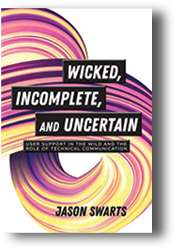 If you’re a technical communicator engaged in user support, you’ll want to grab a copy of Jason Swarts’s Wicked, Incomplete, and Uncertain: User Support in the Wild and the Role of Technical Communication. This seminal book addresses perhaps the most important point for us today: “changes in technologies and our relationships to them are creating new demands for knowledge that are challenging our practices of knowledge creation achieved through traditional technical communication genres.…these demands are also opening up opportunities to redistribute the work of technical communication and reveal opportunities for new kinds of knowledge creation that technical communicators are perfectly able to deliver” (p. 5).
If you’re a technical communicator engaged in user support, you’ll want to grab a copy of Jason Swarts’s Wicked, Incomplete, and Uncertain: User Support in the Wild and the Role of Technical Communication. This seminal book addresses perhaps the most important point for us today: “changes in technologies and our relationships to them are creating new demands for knowledge that are challenging our practices of knowledge creation achieved through traditional technical communication genres.…these demands are also opening up opportunities to redistribute the work of technical communication and reveal opportunities for new kinds of knowledge creation that technical communicators are perfectly able to deliver” (p. 5).
Wicked, Incomplete, and Uncertain hits on precisely the change that many of us face: the evolution away from set pieces of knowledge (often manuals) honed by technical communicators to up-to-the-minute information shared by communities of users seeking answers to problems unanticipated by product developers, with, seemingly, a lack of input by professional documenters.
Swarts labels problems stemming from a community-based approach “wicked” in their making it difficult to plan. In practice, the process of discovering helpful answers to the problems must be recursive and involve non-experts. Not surprisingly, the middle chapters focus on the workings of user forums to generate knowledge.
The concluding chapter, “The Role of Technical Communication,” is uplifting in its turn away from the darkness of uncertainty to the many ways that we can thrive. Swarts’s prose becomes more vigorous as he shows how we can use our familiarity with common users’ tasks to engage individual users, guide communities in creating useful knowledge, and coordinate the work of diverse groups. We are the people who can bring to bear skills in rhetoric, negotiation, workflow management, problem solving, facilitation of interpersonal communication, and the structuring and interpretation of information.
Swarts has written extensively in the past on our relationships with technology. One of his several awards for best article or book, for example, is the STC Frank R. Smith Distinguished Article Award for his 2012 Technical Communication article on using video in help systems. Wicked, Incomplete, and Uncertain is his deepest and most satisfying probe into the shift that we technical communicators are facing, the many devils in its details, and the immense opportunities that we can enjoy.
Avon J. Murphy
Avon J. Murphy is a technical editor in western Washington. A retired college professor and government writer, he is an STC Fellow, a contractor, and principal in Murphy Editing and Writing Services, specializing in computer and Web technologies. Avon served as book review editor for Technical Communication for 17 years.
What Are Your Blind Spots? Conquering the 5 Misconceptions that Hold Leaders Back
Jim Haudan and Rich Berens. 2018. New York, NY: McGraw-Hill Education. [ISBN 978-1-260-12923-6. 162 pages, including index. US$24.00.]
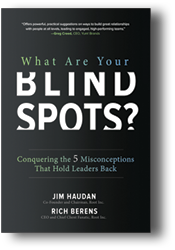 I love how What Are Your Blind Spots? Conquering the 5 Misconceptions that Hold Leaders Back dives straight into Simon Sinek’s “Start with the Why” to kick off the first biggest misconception, Purpose. An exercise takes you through creating a purpose statement for your company, suggesting you invite a few people to collaborate. After discovering your organization’s purpose, the exercise leads you into creating your own personal purpose. The process of discovering your purpose is a powerful leadership tool that we use in many of our classes when training our high potentials to get to the next level. Establishing that meaningful connection is an effective way to drive confidence and empower associates and leaders to become more motivated.
I love how What Are Your Blind Spots? Conquering the 5 Misconceptions that Hold Leaders Back dives straight into Simon Sinek’s “Start with the Why” to kick off the first biggest misconception, Purpose. An exercise takes you through creating a purpose statement for your company, suggesting you invite a few people to collaborate. After discovering your organization’s purpose, the exercise leads you into creating your own personal purpose. The process of discovering your purpose is a powerful leadership tool that we use in many of our classes when training our high potentials to get to the next level. Establishing that meaningful connection is an effective way to drive confidence and empower associates and leaders to become more motivated.
The next blind-spot, Story, opens your eyes to the misconception that your company has a compelling story to tell. I’ve often found in creating an eLearning course that learners will respond well to content presented in a scenario-based format.
Moving into the third blind spot, Engagement, you again consider the priorities of your company which largely include driving/improving engagement scores. The authors cited a Harvard study which identified three main components: intrinsic motivation, connectedness and belonging, and pride. Although the authors did not disapprove of these components, they identified their definition of Engagement differently, viewing it as, “the emotional commitment that people have to their team, the organization, and the strategies of their company.
When looking at the fourth leadership blind-spot, Trust, I couldn’t wait to see what else I could learn. What I found was a lot of storytelling, perhaps a little too much for this message. Eventually, you will have to choose if your culture is rule-based or value-based. From there you can figure out how to best approach the freedom to trust your people to bring their best talents and skills to the table.
The final blind-spot, Truth, dissects the misconception that associates can come to their leaders with all problems. Unless the leader is willing to be vulnerable and create a safe space, most associates will not feel comfortable rocking the boat. Once the floodgates are opened and the truth comes out, associates feel reinvigorated and valued that their perspective is being seen and it gives them hope that they can finally address the real issues. My biggest doubt in this chapter came with the team post-it note exercise, used to draw out issues. The exercise would fail if the culture was not comfortable telling the truth already.
The most powerful lesson you will walk away with is how to better approach your company and fellow leaders with a vision that inspires your associates and draws them in to invest in the same purpose. Each chapter clearly takes you on a journey to get you comfortable with looking at your company through a different lens to better represent your true objective, identify the changes that need to be made for success in the future, and how to best approach those changes.
Kristin Kirkham-Broadhead
Kristin Kirkham-Broadhead is an Instructional Designer, Technical Writer, and Director of Learning and Development from Dallas, TX. She previously served the STC North Texas Lone Star Community as President from 2009–2010. When she is not writing, she loves scrapbooking, photography, and chasing her son around the house.
The Writer’s Style: A Rhetorical Field Guide
Paul Butler. 2018. Logan, UT: Utah State University Press. [ISBN 978-1-60732-809-4. 182 pages, including index. US$22.95 (softcover).]
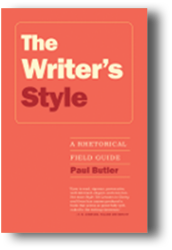 In The Writer’s Style: A Rhetorical Field Guide, Butler condenses a trove of ancient and modern rhetorical wisdom into 12 highly readable chapters that move at a rapid clip. Though not a technical writing book, it covers high, middle, and low style; cites Carolyn Miller, Richard Lanham, and Jeanne Fahnestock; contains an excerpt from one of the late Stephen Hawking’s books; and includes practice exercises relevant to works produced in business and industry. While intended for the college classroom, anyone with an interest in rhetoric and style will find it useful for understanding, appreciating, and making deliberate choices that generate vivid, compelling, and powerful prose.
In The Writer’s Style: A Rhetorical Field Guide, Butler condenses a trove of ancient and modern rhetorical wisdom into 12 highly readable chapters that move at a rapid clip. Though not a technical writing book, it covers high, middle, and low style; cites Carolyn Miller, Richard Lanham, and Jeanne Fahnestock; contains an excerpt from one of the late Stephen Hawking’s books; and includes practice exercises relevant to works produced in business and industry. While intended for the college classroom, anyone with an interest in rhetoric and style will find it useful for understanding, appreciating, and making deliberate choices that generate vivid, compelling, and powerful prose.
Though full of ancient rhetorical terms whose pronunciation alone may put off readers, Butler uses what is in effect a casual use of appositives to define each term, thereby diminishing the intimidation factor. His frequent repetition of rhetorical terms; such as polysyndeton, anastrophe, and anaphora; followed immediately by their definitions, helps readers comprehend, remember, and apply ancient Greek devices, tropes, and schemes, whose technical names are alien to most.
Like other books on the subject, Butler explains that choices in writing must emerge from an understanding of audience, purpose, and context; that effective writers use ethos, pathos, and logos (credibility, passion, and reason); and that writers draw upon the five canons of rhetoric (invention, arrangement, memory, style, and delivery), to persuade, inform, delight, or move an audience. Unlike other, more dense tomes, Butler approaches these subjects not only with scholarship and finesse, but with a brevity and clarity that makes reading The Writer’s Style a pleasure. As he states in the preface, Butler sets out to accomplish these tasks by showcasing exemplary texts, by analyzing them, and by inviting his readers (students) to apply what they have learned using not only the practice exercises included throughout the text, but those from a comprehensive list of assignments in chapter 11.
As with any good text on effective writing, Butler includes excerpts from rhetorical masters like Henry David Thoreau, Abraham Lincoln, John F. Kennedy, Annie Dillard, Susan Sontag, Rachel Carson, and Dr. Martin Luther King, Jr. He, however, chooses to diversify his literary examples by including not only contemporary columnists like David Brooks and Paul Bruni but also voices from the AIDS crisis, like the late Paul Monette.
Butler explains that writers educated and trained to draw upon these ancient practices can name, recognize, and use them at will, while others internalize and call upon them subconsciously from experience with reading and appreciating brilliant writing. Butler addresses our current politically charged milieu where negative connotations are regularly associated with the term “rhetoric.” Regardless, Butler asserts that “… all language is rhetorical” (p. 14), including that used in the character-constrained digital sphere of Twitter. He also delves into applied linguistics, illustrating how mastery of diction, grammar, and syntax can bring power to writing.
Anyone, whether student or professional, interested in either practicing or appreciating effective writing will find The Writer’s Style erudite, engaging, and enlightening.
Allen Brown
Allen Brown is a grant writer and communications specialist for the Marriott Foundation for People with Disabilities. He completed a B.A. in English from University of North Carolina–Greensboro and an M.S. in Technical Communication from Mercer University.
Graphic Design Sourcebook: The 100 Best Contemporary Graphic Designers
Charlotte Fiell and Peter Fiell. 2019. London, UK: Goodman Fiell. [ISBN 978-1-78313-016-0. 512 pages. US$45.00 (softcover).]
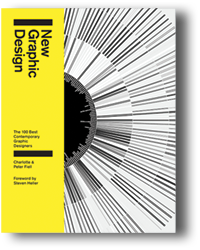 Graphic Design Sourcebook: The 100 Best Contemporary Graphic Designers is a visual snapshot of graphic design from around the world. This book provides a diverse sampling of modern design trends and unique approaches to visual communication from the printed page to exhibition design and every medium in between.
Graphic Design Sourcebook: The 100 Best Contemporary Graphic Designers is a visual snapshot of graphic design from around the world. This book provides a diverse sampling of modern design trends and unique approaches to visual communication from the printed page to exhibition design and every medium in between.
The authors emphasize, in the Introduction, a societal shift in medium preference from print to digital, speculating that traditional graphic design fundamentals are becoming outdated. Specifically, “graphic design has moved from an essentially static medium to one that increasingly possesses a degree of movement, interactivity, and connectivity” (p. 11). These changes have instilled digital fluency and technological adaptability as critical skills for new and experienced designers alike.
For technical communicators, the print-to-digital concept is quite familiar. As more technical communicators incorporate graphic design into their work and more graphic designers create technical content, these once very distinct industries become subject to more of the same shifts in skills requirements and consumer demands.
This sourcebook showcases many designs that are informational or technical, and the corresponding “philosophies” adopted by each designer or agency could serve technical communicators as well. For example:
Coralie Bickford-Smith, United Kingdom: “Good design has to serve the purpose it was intended for” (p. 58): As technical communicators we help people understand concepts and complete tasks, but if we lose sight of the content’s purpose, we reduce our users’ chances of success.
Hilary Greenbaum, United States: “The content is the design, the design is the content” (p.171): Greenbaum’s approach to editorial design reminds us that the value of content itself has reached new heights, and that content quality has become more an expectation than a demand.
Heydays, Norway: “We remove noise to add value” (p. 209): The agency’s clean designs represent another important objective for technical communicators. Regardless of industry, removing excess “noise” to deliver a clear message is a common goal among all communication professionals.
Signal | Noise, United Kingdom: “Touch, swipe, gesture” (p. 369): With the age of artificial intelligence upon us, as communication professionals our factors for success are increasingly impacted by major disruptions to the ways in which we create and deliver content and how consumers interact with it.
Although technical communication and graphic design maintain fundamental differences, “effective communication” remains the primary objective. The authors state, “[W]hat really lies at the heart of graphic design is the transmission of concepts, meanings and values” (p. 8). Additionally, “no one should lose sight of what graphic design is all about: content” (p. 16). In either of these remarks, one could replace “graphic design” with “technical communication.” However, we should also consider the value of “collaboration” between fields. If we were asked to break down more silos within our organizations, graphic design and technical communication seem like two perfect candidates fit for the challenge.
Amy Dunbar
Amy Dunbar is an STC member and a technical writer for Pearson VUE in Bloomington, MN. She has a degree in biology and a graduate certificate in technical communication from the University of Minnesota. Amy’s professional interests include content marketing and video production.
Exercises in Media Writing
Vincent Filak. 2018. Thousand Oaks, CA: CQ Press. [ISBN: 978-1-5443-3810-1. 88 pages. US$35.00 (softcover).]
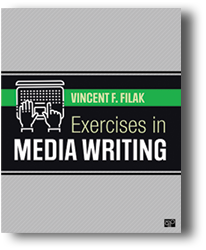 “Just right” were the words that came to mind when reviewing Exercises in Media Writing. As a companion to Dynamics of Media Writing, what we see in this book appears to be an effective mix of useful, interesting materials.
“Just right” were the words that came to mind when reviewing Exercises in Media Writing. As a companion to Dynamics of Media Writing, what we see in this book appears to be an effective mix of useful, interesting materials.
With fourteen major areas, Exercises in Media Writing covers a wide and appropriate array of topics including grammar basics, style, language, accuracy, interviewing, and audience focus. Other traditional topics include writing for public relations, advertising, and marketing. More contemporary topics include writing for the Web and social media, as you would expect.
In the law and ethics chapter, I found a most welcome and appropriate reminder of the five freedoms delineated in the First Amendment of the Constitution: the freedom of press, speech, assembly, petition, and religion.
The answer key is clear and effective. I feel I should mention that the paper used in this book is pleasant to the touch. Exercises in Media Writing is overall, and in both content and presentation, “just right” as you can see.
Jeanette Evans
Jeanette Evans holds an MS in technical communication management from Mercer University. She has worked with groups such as Philips Medical and Cuyahoga Community College doing technical writing and supporting courseware development. Jeanette also co-authored an Intercom column on emerging technologies in education and is currently NEO STC newsletter co-editor.
The Craft of Editing
Adnan Mahmutović and Lucy Durneen, eds. 2019. New York, NY: Routledge. [ISBN 978-1-138-49579-1. 210 pages. US$150.00 (hardcover).]
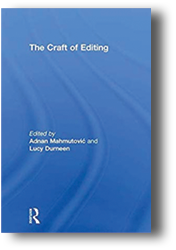 In The Craft of Editing, the editors offer a unique viewpoint into the process of editing by showing how the raw material of a text takes shape through edits, comments, and collaboration between the writer and editor. This book is not a quick how-to guide for becoming a better editor: it is, instead, an in-depth look at the “constant oscillation between what we might consider the near of the writing experience and the more detached, more distant view of the editor” (p. 2). As Mahmutović and Durneen write, “There is no single formula that can, without problems, be applied to all texts. The more advanced the practitioner, the more intricate the process becomes” (p. 3). Rather than provide a one-size-fits-all solution to editing, this book shows how each text brings its own challenges and how those challenges were met by editors on a case-by-case basis.
In The Craft of Editing, the editors offer a unique viewpoint into the process of editing by showing how the raw material of a text takes shape through edits, comments, and collaboration between the writer and editor. This book is not a quick how-to guide for becoming a better editor: it is, instead, an in-depth look at the “constant oscillation between what we might consider the near of the writing experience and the more detached, more distant view of the editor” (p. 2). As Mahmutović and Durneen write, “There is no single formula that can, without problems, be applied to all texts. The more advanced the practitioner, the more intricate the process becomes” (p. 3). Rather than provide a one-size-fits-all solution to editing, this book shows how each text brings its own challenges and how those challenges were met by editors on a case-by-case basis.
The Craft of Editing features published stories from literary journals and magazines, including Guernica Magazine, Orion Magazine, and World Literature Today. Mahmutović and Durneen break the book up into six chapters: the first chapter is an introductory essay by Mahmutović and Durneen that outlines the structure and theory behind the book, and the other chapters consist of five case studies that contain the published version of a story, the edits and comments between the editor and author of the story, and an interview with the editor(s) and author about the process that went into editing and finalizing the story. Seeing how all the marked-up copy, comments, and correspondence between writer and editor add up to a finalized, professional text shows the reader exactly what stays in a text and why, as well as how much of the writing process is collaborative.
What makes this book worth reading is the explication of particular edits and comments during the conversation sections of the book—these are the most entertaining and interesting sections of the book. It is in these sections that editors of all types can learn new skills for working with writers, such as how not to be too intrusive into the writer’s work and how to be diplomatic while still holding firm about one’s ideas. While this book may be “aimed at higher level students of creative writing, from graduate students of MAs and MFAs to experienced writers” (p. 1), there is still much technical communicators can learn from The Craft of Editing. Though some technical communicators and editors may not find the focus on creative work helpful for advancing their craft, many will find the information here useful, especially those with a secondary interest in creative writing.
Dylan Schrader
Dylan Schrader is a graduate student in the MA in Professional Communication program at the University of Alabama in Huntsville, where he also works as a grant researcher in the Office for Proposal Development.
Critical Approaches to Creative Writing
Graeme Harper. 2019. New York, NT: Routledge. [ISBN 978-1-138-93155-8. 122 pages, including index. US$24.95 (softcover).]
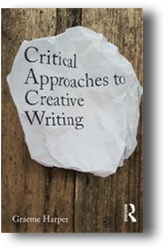 Hundreds of books have been written about the craft of creative writing (CW), with topics like how to structure a novel, use symbolism, build a world, and so on. But in comparison, little academic scholarship followed in areas such as CW studies, process, or pedagogy. Academics researching CW tended to publish in journals covering literature or rhetoric and composition. However, in 2016, after a year of development, Journal of Creative Writing Studies published its first volume, with editor James Ryan writing, “We have reached a critical mass and can no longer fit in the marginal spaces of other disciplines” (p. 1).
Hundreds of books have been written about the craft of creative writing (CW), with topics like how to structure a novel, use symbolism, build a world, and so on. But in comparison, little academic scholarship followed in areas such as CW studies, process, or pedagogy. Academics researching CW tended to publish in journals covering literature or rhetoric and composition. However, in 2016, after a year of development, Journal of Creative Writing Studies published its first volume, with editor James Ryan writing, “We have reached a critical mass and can no longer fit in the marginal spaces of other disciplines” (p. 1).
In literature, “critical approaches” can refer to strategies of analysis or schools of criticism, like post-structuralism or reader response. Other fields use the term to refer to ways of analyzing research or schools of thought on topics within the field. I expected Critical Approaches to Creative Writing to provide something of this sort regarding creative writing scholarship, something with the latest research. I was a bit disappointed to learn that very few sources are cited, and this isn’t the academic text I was hoping to find.
What Critical Approaches to Creative Writing does provide is an explanation of what CW is and how writers practice the art. The introduction reads like a lecture in an introductory course, with nods to “form, style, type, genre” (p. 6) as elements recognized in what he calls “post-event understanding” of the written work. The book “consider[s] the actions of creative writing” (p. 14) for readers who are creative writers, and herein lies a problem: Most experienced creative writers will have an innate sense of their own process and their own CW definition, so the book’s content might tell the writer what she already knows.
The first chapter reviews what Harper calls “features” of literary fiction. After explaining what writing is, he defines imagination and presents some of the ways human imagination works.
Chapters two and three cover influences and practices. Influences range from societal and cultural to individual experiences, such as the last book read or other “models” like structured poems (p. 61). Practices are the three steps: pre-writing, writing, and post-writing. To help the reader better understand how each step in the writing process functions, he renames them: foundation, generation, response. He argues that this renaming and questioning of the process helps “better describe” the CW process. For example, he writes that “response” as a term (versus post-writing) “better capture[s] what occurs in creative writing when we consider what we have been doing and the evidence of what we have done” (p. 75).
Chapter four presents tools to help creative writers look for evidence in their own process—evidence that helps writers develop a “critical awareness” of the “imagination” (p. 94). The last chapter could be the most useful for those early in a graduate program, because it outlines some ways writers might think about and then write about their own creative writing practice.
Kelly A. Harrison
Kelly A. Harrison, MFA, teaches technical writing at Stanford University. In collaboration with a colleague, she recently received an NEH grant for curriculum development at San José State University, where she has taught a range of writing courses. She has written print and online content for various high-tech companies.
An Introduction to Language
Victoria Fromkin, Robert Rodman, and Nina Hyams. 2017. Boston, MA: Cengage. [ISBN 978-1-337-55957-7. 524 pages, including index. US$119.99 (softcover)].
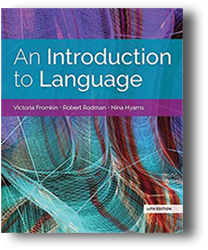 An Introduction to Language has a long tradition that began in 1974 with the book now in its 11th edition. Current edition highlights include an overall revision for “clarity, conciseness, and currency” (p. xii), a “streamlined edition” (p. xiii), with fewer chapters and updates on new developments in linguistics and other relevant fields. As far as textbooks are concerned, the book is easy to read, follow, and most importantly comprehensive.
An Introduction to Language has a long tradition that began in 1974 with the book now in its 11th edition. Current edition highlights include an overall revision for “clarity, conciseness, and currency” (p. xii), a “streamlined edition” (p. xiii), with fewer chapters and updates on new developments in linguistics and other relevant fields. As far as textbooks are concerned, the book is easy to read, follow, and most importantly comprehensive.
When this book’s legacy began, Robert and Vicki Fromkin wanted to “share with students their love of language and linguistics by presenting complex material in a lighthearted and personal way that included witty quotations…and cartoons” (p. xii), and, indeed, this edition is no exception. The text’s readability is one of its most remarkable characteristics because with the content’s breadth and depth, it would be easy to lose readers within the first few pages. However, Fromkin, Rodman, and Hyams are excellent authors who write for audiences of varying levels, including students, graduate students, faculty, and practitioners. The content is highly technical with vocabulary words and complex linguistic concepts and rules. Each chapter is well designed so that readers know exactly what words and concepts to pay attention to; definitions, descriptions, and well-explained examples directly follow new information; the writing is clear and concise; and there are numerous funny quips and cartoons to break up the information.
Although An Introduction to Language is not broken into sections, the first few chapters define language and cover how language is formed and structured and its meaning. The next few chapters cover mostly phonetics, such as sound, sound patterns, and rules, and the last few chapters address issues associated with language and society, changes in language, and how language is acquired and processed. Although language is generally thought of as speech-based, rules and examples of sign languages, such as American Sign Language, are incorporated in every chapter. A summary and references for further reading are part of each chapter, and there are pages of exercises as well, which are helpful for classroom use. The only question that remained with me as I read this book was “this is an introduction to language?” The comprehensive coverage makes it a useful text for linguistics, education, psychology, and cognitive sciences, but it is a text that must be accompanied with careful guidance from an instructor because it would be easy for those being introduced to language and its complexities to become overwhelmed.
Diane Martinez
Diane Martinez is an associate professor of English at Western Carolina University where she teaches technical and professional writing. She previously worked as a technical writer in engineering, an online writing instructor, and an online writing center specialist. She has been with STC since 2005.
Dreyer’s English: An Utterly Correct Guide to Clarity and Style
Benjamin Dreyer. 2019. New York, NY: Random House. [ISBN 978-0-8129-9570-1. 296 pages, including index. US$25.00.]
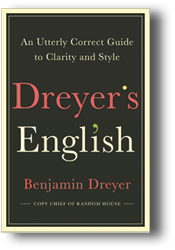 Dreyer’s English: An Utterly Correct Guide to Clarity and Style attacks problems of English usage in much the same spirit as Lynne Truss’s Eats, Shoots & Leaves (2003) and Bill Walsh’s The Elephants of Style (2004). Dreyer is vice president and copy chief at Random House, where he has been editing for over a quarter of a century.
Dreyer’s English: An Utterly Correct Guide to Clarity and Style attacks problems of English usage in much the same spirit as Lynne Truss’s Eats, Shoots & Leaves (2003) and Bill Walsh’s The Elephants of Style (2004). Dreyer is vice president and copy chief at Random House, where he has been editing for over a quarter of a century.
He doesn’t particularly concern himself with 98 percent of the details covered by The Chicago Manual of Style and most other style manuals of our trade—steps in the publishing process, translation, mathematical typesetting, citation styles, innuendoes of punctuation, etc. What he does focus on is his highly personal take on making your English prose readable.
He emphasizes the personal element. As a copyeditor, he bases his judgments mostly on what he has seen, what makes sense, and even what looks visually balanced, preferring the en dashes in “New York–to–Chicago” over the hyphens in “New York-to-Chicago” (p. 63). He lets on that he was “stubbornly avoiding the topic [of the singular they] till it became personal” (p. 95). Personal also is the way he uses his ear—he defends one of his slightly stilted-sounding emendations: “There’s a certain tautness in slightly stilted prose that I find almost viscerally thrilling” (p. 253).
Dreyer writes with a pronounced editorial wink: “On a good day, [copyediting] achieves something between a really thorough teeth cleaning…and a whiz-bang magic act” (p. xii). We have on the misuse of [sic] to imply your superiority, “It’s the prose equivalent of an I’M WITH STUPID T-shirt and just about as charming” (p. 49). He romps through “Notes on Proper Nouns,” observing, for example, on the spelling of Mississippi: “Some people, present company included, cannot ever spell it correctly without singing the song” (p. 228).
The author’s idiosyncratic sense of humor dominates most pages. It lets him down only when he writes of something most people with a high school education have learned early on, as in the tepid chapter on non-U.S. spellings and grammar.
The book is intended for a literate generalist audience. For technical communicators, Dreyer’s English is a book to relax and have fun with. You can consult your Chicago and Publication Manual of the American Psychological Association throughout your workday, but in your off hours you want to sit back and just enjoy the enthusiasm and oftentimes giddy sense of fun with language that permeates Dreyer’s English.
Avon J. Murphy
Avon J. Murphy is a technical editor in western Washington. A retired college professor and government writer, he is an STC Fellow, a contractor, and principal in Murphy Editing and Writing Services, specializing in computer and Web technologies. Avon served as book review editor for Technical Communication for 17 years.
The Secret to Cybersecurity: A Simple Plan to Protect Your Family and Business from Cybercrime
Scott E. Augenbaum. 2019. Forefront Books. [ISBN 978-1-948677-08-0. 192 pages. US$27.00.]
 Unfortunately, it has become common to hear about another Internet security breach. With more of our lives being tied daily to the Internet, we increasingly have more to lose if our accounts are compromised. Augenbaum’s book, The Secret to Cybersecurity: A Simple Plan to Protect Your Family and Business from Cybercrime, breaks down Internet threats and teaches you how to prevent, avoid, or deal with them in easy to understand terms.
Unfortunately, it has become common to hear about another Internet security breach. With more of our lives being tied daily to the Internet, we increasingly have more to lose if our accounts are compromised. Augenbaum’s book, The Secret to Cybersecurity: A Simple Plan to Protect Your Family and Business from Cybercrime, breaks down Internet threats and teaches you how to prevent, avoid, or deal with them in easy to understand terms.
Augenbaum relies heavily on his extensive career in the FBI investigating cybercrime to convey the proper weight of poor Internet security. Each point includes a real-life example of how people were defrauded or otherwise compromised over the Internet. In Chapter 15, Ransomware, a situation where a third party encrypts your computer and demands payment in bitcoin to unlock it, the author describes several real-world events. These examples really emphasize how vulnerable you or other groups may be to online attacks. Topics discussed include elder scams, dating scams, phishing, and social media downfalls.
Fortunately, Augenbaum provides sound advice on how to avoid common online pitfalls. Throughout The Secret to Cybersecurity, he comes back to two main concepts: strong, unique passwords and two-factor authentication. One common problem is that people re-use passwords across multiple accounts. So, if your website is compromised, that hacker may gain access to your email and other accounts, if the same password was used. Creating and keeping track of multiple passwords is difficult, so Augenbaum presents recommendations on how to structure your passwords and where to store them. (Hint: It is not in a file in your Google drive.) Coupling strong passwords with two-factor authentication is an excellent way to protect your accounts. Two-factor authentication requires that you have your cell phone present to log into your email or other online accounts. When you try and sign into your email account, a pop-up appears on your phone that you must acknowledge to access your email. That way, if your password is compromised, the hacker cannot use the account unless they have also stolen your cell phone. What Augenbaum does not do is give advice on configuring hardware to be more secure. For example, he does not tell you how to set up your wireless router to use stronger security.
Throughout The Secret to Cybersecurity, you will be presented with multiple scenarios that you can identify with and will terrify you. Almost every scenario listed could have been prevented if a strong password with two-factor authentication had been used, along with a good sense of what to click or not click on in the Internet. Will reading this book completely protect you from online attacks? Probably not. It should prepare you by strengthening your Internet knowledge and boosting your own online security procedures. This book is a resource that most people should read for their own safety and that of others.
Timothy Esposito
Timothy Esposito is an STC Fellow with over 18 years of technical communication experience. He is the past president of the STC Philadelphia Metro Chapter. Before becoming president, Timothy was chapter vice president, treasurer, webmaster, and scholarship manager.
Writing Successful Science Proposals
Andrew J. Friedland, Carol L. Folt, and Jennifer L. Mercer. 2018. 3rd ed. New Haven, CT: Yale University Press. [ISBN 978-0-300-22670-6. 264 pages, including index. $22.00 (softcover).]
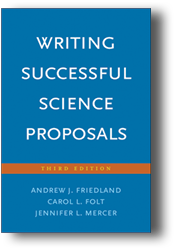 Many topics discussed in the third edition of Writing Successful Science Proposals are common to proposal writing in general. But some are “new.” And some bring a fresh perspective to those perennial topics; especially the crucial concept of audience, that runs throughout the book. The application forms are drawn chiefly from the NSF and NIH, NASA and the EPA, that together make up the largest pool of science funding.
Many topics discussed in the third edition of Writing Successful Science Proposals are common to proposal writing in general. But some are “new.” And some bring a fresh perspective to those perennial topics; especially the crucial concept of audience, that runs throughout the book. The application forms are drawn chiefly from the NSF and NIH, NASA and the EPA, that together make up the largest pool of science funding.
Let’s focus on the topic of audience. Stressing the importance of titles, the authors point out that some evaluators may not be specialists in your field, so you need a title they would understand. “Could a few word changes in the title” make the proposal more accessible to them (p. 67). The Project Summary, or Abstract, is an important piece of a proposal. Agencies also expect scientists to write a Summary that is understandable to a scientifically literate lay audience. In addition, the Abstract is that document part that is the most likely to find its way onto the Web, and so, we have another audience to consider.
The concept of audience also plays a major part in crafting the Research Plan. An important element of the Research Plan is a subsection called Broader Impacts. This may include several audiences, such as (1) outreach: engaging with people outside the scientific research community; (2) education: students of any age; (3) synergies: collaborating with people from different fields; (4) public impact: benefits to society; and (5) public knowledge.
Chapter 8, Introduction, is another major piece that looms larger in a proposal than in many other genres of writing. But even here, the authors urge the reader to remember the non-specialist reviewer and suggest avoiding digressions and unnecessary details. Don’t drown the reader in references. And don’t make the Introduction too long. And, ah yes, visuals. The authors stress that “reviewers often prefer to examine a figure or table embedded in the text rather than to read two or three paragraphs of prose” (p. 126).
Another fresh perspective is the concept of Team Science (Chapter 17): Much of scientific research today is done in teams or as multidisciplinary research. The authors offer three terms commonly used to describe the various types of multidisciplinary research; each of which brings with it further considerations of audience. The first is “systems science”: bringing together systems from different disciplines, such as biological or ecological systems, social systems, or economic systems––to examine pressing problems. Common technical terms in one field may be unfamiliar to researchers in another field. The same problem arises with the other two: “convergence science” and “integrative science.” These types combine the knowledge and perspectives of different sciences for solving research problems. You can imagine, in these three areas, the need for a whole new vocabulary for the researchers to collaborate successfully on their projects.
Tetyana Darian
Tetyana Darian is an STC member and is finishing her Master’s in Mathematics at Rutgers University. She will soon start on her doctoral studies in Computational and Integrative Biology. Tetyana’s interests are in scientific computing, cybersecurity, and artificial intelligence.
Lessons in Leadership: The 12 Key Concepts
John Adair. 2018. New York, NY: Bloomsbury Publishing. [ISBN 978-1-4729-5693-4. 172 pages, including index. US$28.00 (softcover).]
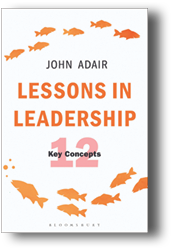 Adair’s book Lessons in Leadership: The 12 Key Concepts starts with a historical account of leadership, specifically as it relates to the armed forces. The first couple chapters are used to establish Adair as a trusted source on leadership by discussing his academic work and previous books.
Adair’s book Lessons in Leadership: The 12 Key Concepts starts with a historical account of leadership, specifically as it relates to the armed forces. The first couple chapters are used to establish Adair as a trusted source on leadership by discussing his academic work and previous books.
It isn’t until chapter four that you are introduced to Adair’s Three-Circles model which describes teams as having three overlapping areas of need: task, team, and individual. These concepts are continually at play in a team and determine the group’s “unique ethos” or “group personality.” According to Adair, “Work groups are more than the sum of their parts: They have a life and identity of their own” (p. 54). As he points out, the value of this model is that it takes the focus from the leader and puts it on the group so that we can consider the leader’s role in facilitating and growing the group’s personality.
In the next chapter, Adair focuses on the role of the leader which he argues is shaped common tasks that are found in all work groups. He introduces a new Three-Circle model for the generic role of leader: achieving the task, building and maintaining the team, and developing the individual. “In order for the three overlapping areas of leadership responsibility to be met, certain functions need to be performed. A function is what you do, as opposed to quality, which is what you are or what you know” (p. 69).
Adair begins pulling the threads together in chapter six with a definition of a leader: “A leader is the sort of person with the appropriate qualities and knowledge – which is more than technical or professional – who is able to provide the necessary functions to enable a team to achieve its task and to hold it together as a working unity. And this is done not by the leader alone but by eliciting the contributions and willing cooperation of all involved” (p. 87).
The rest of the book explores the qualities a leader needs: enthusiasm, integrity, tough and demanding but fair, warmth and humanity, humility, the strategic leader, practical wisdom, and beliefs and hopes. All include wonderful information about the attributes a leader needs to imbue.
I found this book to have great information but ultimately had trouble engaging with the material, which was explained with continued references to past military forces. Further, it wasn’t clear to me what the 12 concepts were. The book built from models and approaches explored in the first half of the book, but I wasn’t clear on how they were counted as key concepts.
In conclusion, if you’re just being introduced to Adair’s work as I am, this might not be the book to start with. Instead, you might want to explore his newest book How to Lead Others: Eight Lessons for Beginners, which I can only assume would be more geared to an audience not familiar with his work.
Sara Buchanan
Sara Buchanan is an STC member and a content strategist at LCS. She is also an avid reader and coffee drinker, spending much of her free time doing one or the other.
Structured Writing: Rhetoric and Process
Mark Baker. 2018. Laguna Hills, CA: XML Press. [ISBN 978-1-937434-56-4. 490 pages, including index. US$39.95 (softcover).]
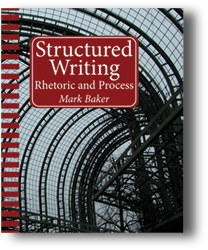 Technical communication professionals are continually pressured to create new content quickly, repurpose existing content for new media, translate content to new languages, and keep up with aggressive development timeframes—and they’re expected to do all this with fewer resources. Given these pressures, the case for embracing structured authoring has never been clearer. However, many technical writers, editors, and managers quietly avoid eye contact when you mention XML, DITA, or markdown. This needn’t be the case.
Technical communication professionals are continually pressured to create new content quickly, repurpose existing content for new media, translate content to new languages, and keep up with aggressive development timeframes—and they’re expected to do all this with fewer resources. Given these pressures, the case for embracing structured authoring has never been clearer. However, many technical writers, editors, and managers quietly avoid eye contact when you mention XML, DITA, or markdown. This needn’t be the case.
Mark Baker’s Structured Writing: Rhetoric and Process is a veritable bible on structured authoring, providing a thorough exploration of writing, content development, markdown, and process. The book offers something for a variety of audiences. For the technical writer who is apprehensive about structured authoring, this book explains how all writing is structured and adding a few more structured bits will make content more versatile. For the manager who doesn’t understand what the writers are fussing about, the book explains the writing process and the challenges that arise from partitioning complexity. For the lead who sees the team struggling under a mountain of unmanageable content, this book provides the language for articulating the need for structured authoring processes, system design, and the benefits of structured writing to the organization.
Because the audience is so broad, seasoned writers may find the first five chapters tedious, because they describe basic aspects of content creation (albeit with insightful examples and illustrations), but they are necessary for the author to lay the foundation for what structured authoring is and why it’s necessary. Having said that, Baker takes great care in dividing the book into manageable chunks to enable readers to dive into specific areas that interest them. There are 44 chapters arranged into 8 sections. You could say that the book itself models structured authoring with manageable, focused topics and frequent headings.
Structured Writing runs the gambit from describing the nitty gritty distinctions between different types of variables and algorithms to defining and describing various markdown languages. If all that sounds daunting, don’t worry, the book contains many diagrams that help illustrate the abstract concepts being described and textual examples that bring them to life. A notable example the great lengths the book takes to make the examples digestible is its adoption of a simple markdown language called SAM to illustrate the structure of content. SAM proved useful for demonstrating concepts without forcing the reader to simultaneously learn or brush up on XML syntax.
While Structured Writing is not a tutorial on implementing a structured authoring solution, a content management platform, or a single sourcing tool, it gives readers a comprehensive rundown on the theories and requisite understanding required to make these technologies work well. This book represents the sort of confident knowledge that could only be obtained through decades of content development and delivery, and Structured Writing would be a suitable text in a technical communication graduate course.
Michael Opsteegh
Michael Opsteegh is an STC Senior Member and a technical writer in the software and financial services industries since 2004. He is a lecturer in the technical communication program at Cal State Long Beach. Michael holds a master’s degree in English and is a Certified Technical Professional Communicator (CPTC).
Technical Blogging: Amplify Your Influence
Antonio Cangiano. 2019. 2nd ed. Raleigh, NC: The Pragmatic Programmers, LLC. [ISBN 978-1-68050-647-1. 278 pages. US$25.95 (Beta eBook).]
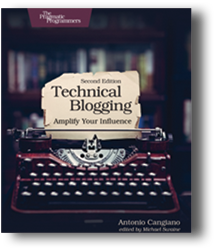 Few technical communicators have blog websites that reach the pinnacle of success and profitability, which Cangiano describes in Technical Blogging: Amplify Your Influence. Have we ever wondered why, or considered how to better promote our technical blog and expand its outreach/community? Wonder no more. Cangiano not only advises what you should do, he then instructs on concepts and tool sets you can use to make it happen. Great information for a corporate blogger or newbie/paraprofessional bloggers, too.
Few technical communicators have blog websites that reach the pinnacle of success and profitability, which Cangiano describes in Technical Blogging: Amplify Your Influence. Have we ever wondered why, or considered how to better promote our technical blog and expand its outreach/community? Wonder no more. Cangiano not only advises what you should do, he then instructs on concepts and tool sets you can use to make it happen. Great information for a corporate blogger or newbie/paraprofessional bloggers, too.
This second edition begins with the mental thought processes that should occur before building a blog site. Will the blog’s main content serve a general audience or niche market? Is your writing more instructional or that of a pundit? What are your company goals…how will you measure success?
Cangiano then launches into detailed instructions on how to use WordPress to set up, format, acquire attention from search engines, and collect data from site visitors. WordPress was chosen because it ranks high among those bloggers who might not want to invest in high-end tool sets early on. WordPress can be easily customized with themes, menus, side bars, and social media icons. Yet it is professional enough to enter SEO metadata and even code. Inexpensive blog sites tend to allow one or the other…not necessarily both.
To rank in search engines, your blog should have a domain name and be registered before construction. Technical communicators will quickly agree when Cangiano declares that Content is King. We may be tempted to do all the writing ourselves. However, guest bloggers or a paid content writer can add sparkle to a site while we research the best links and tricks to raise blog rankings. Of second importance is Consistency, which Cangiano declares to be Queen of the blog. Random posts may attract a reader, but consistent high-quality content will bring them back, likely as consumers or fans who tell others. Cangiano suggests the best date for weekly postings and other strategies.
High visitor volume may let you participate in affiliate marketing which can earn a substantial amount of money. If someone follows an ad from your site and goes on to purchase the affiliate’s product, you will receive a cash reward for the purchase. If you have managed to generate a large audience, look for affiliates who provide relevant services and products that you can promote based on the demographics of your traffic and your blog’s native language.
Studying new techniques and applying latest trends to your company blog site could do much to attract new readership. Find images and videos online which can be matched to keywords and tracked through SEO. Consider Technical Blogging as a savvy Web designer―an excellent addition to your blog’s game plan.
Donna Ford
Donna Ford has been an STC member, served on her local chapter’s board for many years, and holds a certificate in Information Design from Bentley College. She has been a technical writer in hardware, software, and government healthcare industries. Donna also reviews books online for the US Review of Books.
Four Words for Friend: Why Using More Than One Language Matters Now More Than Ever
Marek Kohn. 2019. New Haven, CT: Yale University Press [ISBN 978-0-300-23108-3. 250 pages, including index. US$27.50.]
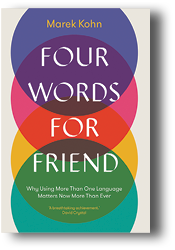 When I first approached Kohn’s Four Words for Friend: Why Using More Than One Language Matters Now More Than Ever, I had just embarked upon my journey to learn French: the native tongue of my French-Canadian family. Like many grandchildren of immigrants, the use of our ancestral language had slowly petered out over the generations. I always had the sneaking suspicion that, because I did not know French, I could not ever fully enjoy cultural membership to the Québécois community. According to Kohn, my suspicion was probably correct.
When I first approached Kohn’s Four Words for Friend: Why Using More Than One Language Matters Now More Than Ever, I had just embarked upon my journey to learn French: the native tongue of my French-Canadian family. Like many grandchildren of immigrants, the use of our ancestral language had slowly petered out over the generations. I always had the sneaking suspicion that, because I did not know French, I could not ever fully enjoy cultural membership to the Québécois community. According to Kohn, my suspicion was probably correct.
In the text, Kohn makes a strong, well-supported case for the necessity of learning other languages. He posits that languages are “the souls of nations” (p. 10). To understand even a fraction of a language offers the speaker insight into a culture in a way that non-speakers can’t achieve. A more thorough grasp of the language allows the speaker to “enter a community, even if only as a guest” (p. 128).
Four Words for Friend makes some salient points that offer a different view of the ways we approach translation and localization in technical communication. The first point concerns the use of italics to set apart words or phrases in another language. While technical communicators are usually constrained by the directions in their client’s style guide of choice, Kohn advises against such a move: “They smack of othering, the practice of exclusion from in-groups by the use of labels or rhetorical artifice” (p. 11). Instead, he suggests that writers should refrain from setting artificial limits between languages within our writing, because the reader should feel that other languages are accessible to them. This sense of belonging for other languages enhances the reader’s understanding on more than the text’s surface level.
Kohn also advises limiting the use of machine translation (MT), when practical. As technical communicators working in localization know, MT cannot capture the tone or nuance of a language, which is integral to understanding the text’s meaning. He likens the use of MT or machine interpreting to the use of a calculator. A calculator, or MT device, is useful, but the person who can do sums or understand a language with less reliance on the machine will always have a distinct advantage over those who cannot. The take-away for technical writing is to reserve MT for straightforward texts that are less hindered by the lack of nuance, and to continue to encourage students to learn another language.
Four Words for Friend is an essential text for technical communicators working in international technical writing and localization, as well as for students hoping to go into this field. Language is more than the sum of its parts or substituting the correct word for another: it carries the worldview, thought processes, and even the history of a culture. In our global environment, we need to not just have access to a translation but to the culture and worldview of other cultures, if we wish to localize our products and information effectively.
Nicole St. Germaine-Dilts
Nicole St. Germaine is an Assistant Professor in the Technical and Business Writing Program at Angelo State University, as well as a freelance writer and consultant. Her research interests include technical communication for a Mexican-American audience and technical communication in the health fields.


[…] from Cybercrime by Scott Augenbaum My rating: 4 of 5 stars This review originally appeared in Volume 66 | Issue 3 of Technical Communication. Unfortunately, it has become common to hear about another Internet security breach. With more of […]